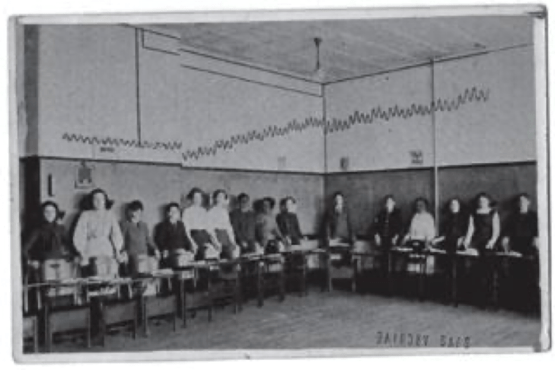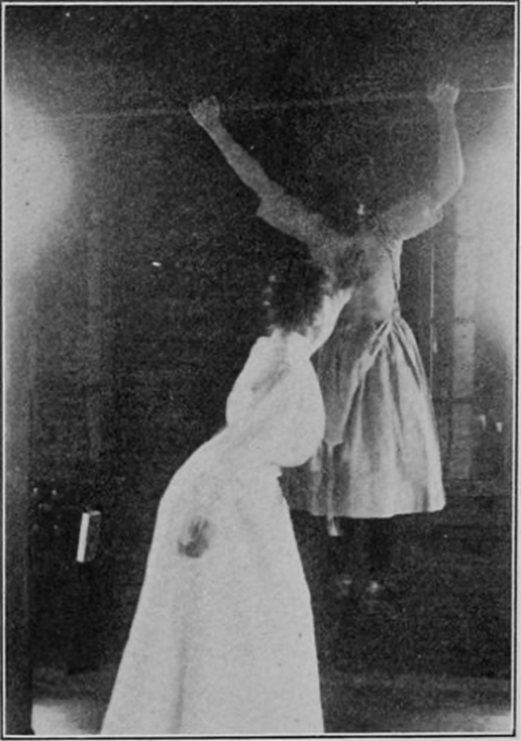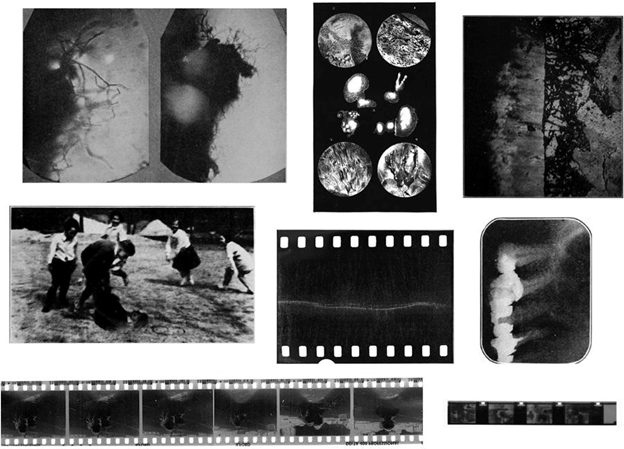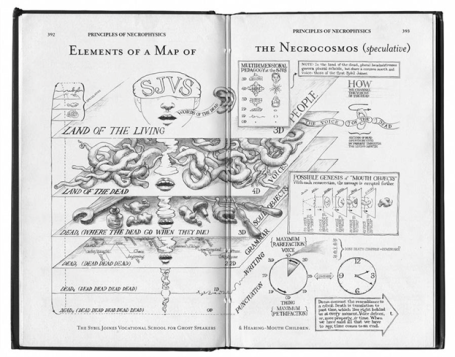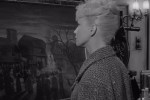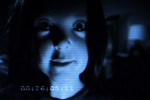Callie Ingram
Riddance: or, the Sybil Joines Vocational School for Ghost Speakers and Hearing-Mouth Children (2018) by Shelley Jackson is a multimodal gothic novel that straddles the boundary between the literary “found manuscript” trope and “found footage” aesthetics. A 512-page dossier about the Sybil Joines Vocational School (SJVS), a spiritualist boarding school where children with speech impediments are trained to channel the dead through their stuttering, the book is posited as both an edited anthology and a trove of potential evidence for the cold case murder of a regional school inspector. Through multiple “found” artifacts, the novel critiques the institutional record-keeping practices and discourses that determine what counts as historical evidence within a given culture—what we might call the archive. These artifacts range from written material, such as a transcribed communication from the first Headmistress Sybil Joines in the land of the dead, the personal epistolary narrative of stenographer Jane Grandison, a selection of “Letters to Dead Authors,” and a variety of other documents under the category of “Readings”; to visual media, such as photographs, film stock, pages from “necrophysics” textbooks, and ectoplasm charts, either appropriated or created by Jackson. In taking on the dossier novel form, Riddance makes explicit the tacit concerns about mediation and representation that lurk in found footage horror aesthetics. In doing so, the book challenges its audience to reconsider the source of the archive’s authority to create and validate official histories.
If found footage horror films have anything in common beyond formal aesthetics, Xavier Aldana Reyes writes, it is a “preoccupation with the concept of reality” and “an inclination to question the function of images purporting to pass for the real thing” (131). One way found footage draws reality into question is through producing what Jaimie Baron calls “the archive effect”—an audience response that imbues found material with the evidentiary authority of “real” historical record. This is due to its display of temporal and intentional disparity, or the way found footage seems to originate from some earlier, more primary source which is now being repurposed for some new context and intended use (Baron; Heller-Nicholas 14). For found footage horror specifically, the archive effect may be produced by a genuine misrecognition of the “found” material’s fictionality. However, more often than not, found footage horror invites the audience to suspend their disbelief in order to experience the archive effect, instead provoking a pleasurable anxiety about the “found” material’s authenticity. While the ultimate recognition of the found material’s simulation may allow the audience to enjoy this “false” archive effect safely—without actually threatening their belief in what’s real—this production of pleasurable anxiety nonetheless carries a tacit challenge to the archive itself. When an audience is simultaneously affected by found footage and aware of its simulated nature, the representational authority of “real” footage—those archival materials that are meant to give immediate access to “real” history—are implicitly thrown into question as similarly constructed or empty.
Similarly, while the novel has long been marked by its dynamic relationship to the archive, the use of “found” materials in the novel creates its own kind of archive effect. Since its formation, the novel has relied upon the archive to produce legible meaning, whether through reference to oral storytelling, legal testimony, letter-writing, or other documentation. In the “dossier novel,” as theorized by Marco Codebo, the direct incorporation of archival forms and modes beyond narrative engages this relationship more visibly (Narrating from the Archive). While early dossier novels often deployed this form to create an aura of authority—like the “found manuscript” trope used by many early gothic novels to “counterfeit authenticity” (Sawczuk 225)—the postmodern dossier novel that emerged in the twentieth and twenty-first centuries moved toward parody. Through self-reflexivity and metafictional play, these later dossier novels instead take on the archive as an object of critique: “Rather than representing the archive as a model of organized and veridical knowledge, as nineteenth-century novels did,” Codebo claims, “their postmodern counterparts portray it as an unreliable institution that cannot sort out its records and too often cheats on its own rules” (“The Dossier Novel”).
In Jackson’s contemporary gothic tale, these two traditions intersect. Riddance’s most obvious tie to found footage horror is its inclusion of visual media, particularly indexical and iconic archival materials like film stock, photographs, and object drawings (see figs. 1 and 2). Like found footage recordings, these appropriated and fabricated materials are assumed to have unmediated (or at least less mediated) access to their pictured entities, especially in contrast to narrative description. Moreover, in claiming to record traces of supernatural occurrences like ghostly ectoplasm (see fig. 3), Riddance’s photographs align with “found footage horror’s frequent mission to capture the elusive and ethereal paranormal” (Heller-Nicholas 21). This mission, which empowers found footage horror to playfully arouse its audience’s sense of realism, here produces the same reaction in the novel’s readers: pleasurable anxiety about the material’s authenticity, and an intensified awareness of the mediating technologies involved in any representation.
Jackson also follows found footage horror, especially as popularized by The Blair Witch Project (1999), in creating a larger intertextual network to heighten the archive effect afforded to the book. Two different texts, each labeled as another document from the SJVS archive, were published separately from the novel: one claiming to be a recovered file, complete with editorial introduction, annotations, and fabricated citations (“Early Dispatches”), and another described as a “white paper on literature, first issued by the SJVS in 1963, revised and expanded in 1996, and updated in 2013” (“The Shelley Jackson Vocational School”). Much like how found footage horror films such as The Blair Witch Project and the Cloverfield series participate in alternative reality games during marketing to drive audience speculation, Riddance does not exist as a simple contained plot but instead proposes an alternative history from multiple sources. If Jackson does this with an obvious wink, eliding the difference between “Sybil Joines” and “Shelley Jackson,” it only goes to show that her intention is less to create the archive effect than to sensationalize and expose its inherent tensions.
These latent concerns of found footage horror are thrust into the spotlight by Jackson’s self-conscious use of the dossier structure. Like other dossier novels, the story emerges from within recognizable documentary forms: Riddance begins with an editorial introduction by an unnamed, contemporary historian of the American spiritualist movement. This academic not only introduces and frames the dossier, explaining how they found, collected, and arranged these archival materials to become an edited anthology, but also appears throughout the work to contextualize each new document and add digressive endnotes.
Both the gothic suspense of the novel and the thrill of “foundness” originates in the editor’s description of the haphazard, almost fateful way that information about SJVS fell into their lap—literally at first, with a newspaper clipping about a murder at the school, fallen from a 1910-20s elocution handbook in a used bookstore (see fig. 6). The editor narrates their research trajectory, discovering ghostly traces of references to the school in newspapers, thrift stores, a stray paper airplane, bags left on a curb, old philosophy listservs, and a customer review of waterproof loafers (6). “It is a common occurrence, and not just among scholars, for a new obsession to awaken reverberations in the most unlikely places,” the editor admits, “Probably there is nothing really uncanny about it; the observer is newly alert to these echoes, that’s all. But it was pretty peculiar, all the same, how rapidly my archives grew” (6). This uncanniness finally crosses the line into the paranormal when the editor describes receiving a cease-and-desist letter from “the fourth-generation reincarnation—in the special sense of a person channeling another’s ghost—of Sybil Joines,” the school’s headmistress (7), who eventually consents to the anthology and allows the editor access to the SJVS archives.
With this turn, Riddance transforms: beyond its formal aesthetics, the story itself uses the speculative conceit of spiritual mediumship to address the archival anxieties provoked by found footage horror and the dossier novel. The editor cautions:
A note to scholars: Any historian of the Vocational School is faced with peculiar difficulties. Its scribes and archivists alike were in agreement that a self is a mere back-formation of a voice that itself belongs to no one, or to the dead. Thus authorship would be a vexed question even if all Vocational School documents were signed, as many were not. (7)
The ability to channel the dead through spiritual mediumship poses a conceptual challenge to the assumption of authentic self-expression, whether in immediate speech or documentation. Even before the concerns of recording technologies become relevant, the representational authority of the individual voice is complicated by “ghost speakers”: the mediation of the photograph or transcript is secondary to the interrupting presence of others in speech. As a writer who has long explored the slipperiness of language and its contradictions (as both a means to construct knowledge about the world and a symbolic structure divorced from the world), Jackson uses spiritual mediumship to literalize the fact that language itself is already a mediating technology. As a result, the “authorship” of SJVS documents is “vexed” in a way that troubles even the seemingly innocuous validating markers of the archive (like a signature). By the time the novel ends and the editor intimates that they, too, may have had the dead speaking through them (“Maybe my prose has already betrayed, to an astute reader—or a computer program analyzing word usage frequency patterns—the presence of an interloper” (Riddance 483)), the reader has been encouraged to consider the presence of language on the page as not entirely indicative of any specific character and as potentially coming from anyone, living or dead.
Alongside this foundational complication of representational authority within the narrative, Riddance challenges our contemporary view of specific histories and the archives that authorize them. Particularly for a US audience, the history of SJVS interweaves and augments current conceptions of nineteenth- and early twentieth-century developments in medicine, science, and industry. The most difficult elements of the novel to dismiss as fictional are the medical images and documentation, which speaks to how Jackson’s “found” materials play into a contemporary audience’s understanding of early medicine and science and its fetish for the apparatus, the textbook (see fig. 4), and the training manual (see fig. 5)—histories and forms that have shaped our current day practices. More significantly, however, Jackson doesn’t use these recognizable archival histories as a mere backdrop for the paranormal plot—she incorporates the formal aesthetics of these archives (overexposed film and photographs, period-appropriate typography) and their cultural values (the emphasis on educational standardization, labor productivity, societal assimilation, entrepreneurial invention) in her production of SJVS spiritualist content. The audience is not simply asked to suspend disbelief but instead to actively negotiate their belief as the paranormal meets and finds purchase in the authorized institutional discourses of the day. This is doubly fraught when considering the way that nineteenth and early-twentieth century spiritualism developed alongside and in tension with the dominant institutional discourses of objectivity and measurement during the period—in other words, Jackson’s alternative history builds on a subordinated one.
This provokes the reader to interrogate not just the authenticity of the documents in front of them but the authority of the original documents and discourses being parodied. When these official histories are suddenly called into question, the reader is confronted by the historical abuses of the archive’s authority: the validation of misinformation and cultural biases, the misrepresentation of events and peoples, the erasure of perspectives that were considered irrelevant, and the ways that this historical authority is still used to support harmful beliefs and unfair practices today. The book is set at a boarding school for children who stutter or stammer, centering a history of disability often erased from the archive. By combining this history with the spiritualist movement and endowing her characters with the ability to speak to the dead, Jackson creates an alternative history that threatens the archive’s ability to authenticate. Ultimately, in parodying these particular historically-situated forms of institutional discourse, Jackson urges readers to direct their anxiety about authenticity away from the found material itself and instead toward the official histories that Riddance claims to supplement.
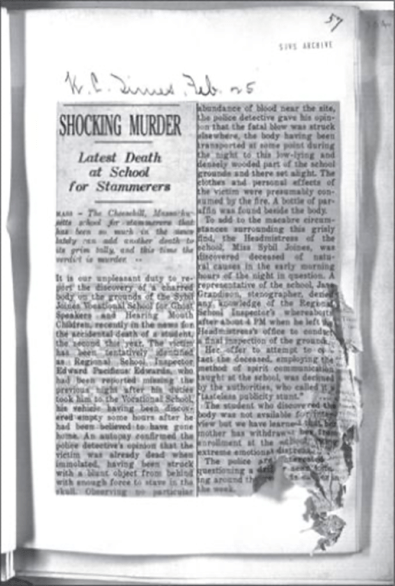
Fig. 6 – Newspaper clipping about the murder of a school inspector from the SJVS archive (Riddance 2).
Riddance, as a dossier of found materials from the SJVS archive, presents us with two kinds of haunted mediums: its student ghost speakers, who are spiritual mediums for the dead, and the archival documents that make up the book. Both found footage and the novel cannot escape their attachments to the archive, which validates their meaning-making forms. However, Jackson uses found footage horror aesthetics and the dossier novel form to make these attachments explicit and to provoke an anxiety in the audience about the implications of the simulated archive effect for any representation of history. Her use of the dossier novel form allows for a more self-reflexive engagement with found footage horror, unearthing its inherent concerns with mediation and representation of reality. Ultimately, the book invites its readers to reconsider the authority of the official histories they’ve been handed down, both about the past and as it pertains to our contemporary moment, and to recognize that it is the archive itself which constructs and confers authenticity, rather than simply housing it.
Works Cited:
Aldana Reyes, Xavier. “Reel Evil: A Critical Reassessment of Found Footage Horror.” Gothic Studies, vol. 17, no. 2, Nov. 2015, pp. 122–36.
Baron, Jaimie. The Archive Effect: Found Footage and the Audiovisual Experience of History. Routledge, 2014.
Codebo, Marco. Narrating from the Archive: Novels, Records, and Bureaucrats in the Modern Age. Fairleigh Dickinson UP, 2010.
———. “The Dossier Novel: (Post)Modern Fiction and the Discourse of the Archive.” InterActions: UCLA Journal of Education and Information Studies, vol. 3, no. 1, 2007.
Heller-Nicholas, Alexandra. Found Footage Horror Films: Fear and the Appearance of Reality. McFarland, 2014.
Jackson, Shelley. “Early Dispatches from the Land of the Dead: From the Archives of Shelley Jackson Vocational School for Ghost Speakers & Hearing-Mouth Children.” Conjunctions, no. 51, 2008, pp. 88–102.
———. Riddance: or, the Sybil Joines Vocational School for Ghost Speakers and Hearing-Mouth Children. Black Balloon Publishing, 2018.
———. “The Shelley Jackson Vocational School for Ghost Speakers and Hearing-Mouth Children.” Ways of Re-Thinking Literature, edited by Tom Bishop and Donatien Grau, Routledge, 2018, pp. 165–72.
Sawczuk, Tomasz. “Taking Horror as You Find It: From Found Manuscripts to Found Footage Aesthetics.” Text Matters, vol. 10, 2020, pp. 223–35.

